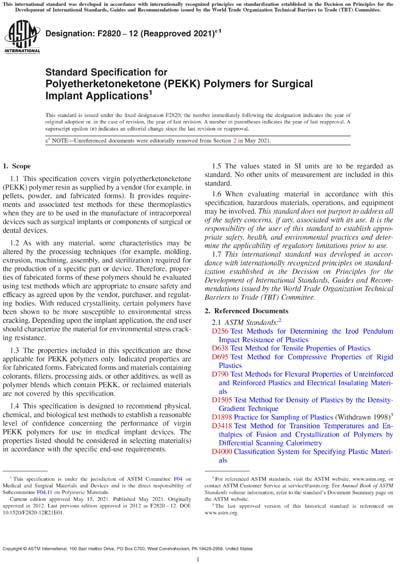Most recent
ASTM F2820-12(2021)e1
Standard Specification for Polyetherketoneketone (PEKK) Polymers for Surgical Implant Applications
1.1 This specification covers virgin polyetherketoneketone (PEKK) polymer resin as supplied by a vendor (for example, in pellets, powder, and fabricated forms). It provides requirements and associated test methods for these thermoplastics when they are to be used in the manufacture of intracorporeal devices such as surgical implants or components of surgical or dental devices.
1.2 As with any material, some characteristics may be altered by the processing techniques (for example, molding, extrusion, machining, assembly, and sterilization) required for the production of a specific part or device. Therefore, properties of fabricated forms of these polymers should be evaluated using test methods which are appropriate to ensure safety and efficacy as agreed upon by the vendor, purchaser, and regulating bodies. With reduced crystallinity, certain polymers have been shown to be more susceptible to environmental stress cracking. Depending upon the implant application, the end user should characterize the material for environmental stress cracking resistance.
1.3 The properties included in this specification are those applicable for PEKK polymers only. Indicated properties are for fabricated forms. Fabricated forms and materials containing colorants, fillers, processing aids, or other additives, as well as polymer blends which contain PEKK, or reclaimed materials are not covered by this specification.
1.4 This specification is designed to recommend physical, chemical, and biological test methods to establish a reasonable level of confidence concerning the performance of virgin PEKK polymers for use in medical implant devices. The properties listed should be considered in selecting material(s) in accordance with the specific end-use requirements.
1.5 The values stated in SI units are to be regarded as standard. No other units of measurement are included in this standard.
1.6 When evaluating material in accordance with this specification, hazardous materials, operations, and equipment may be involved. This standard does not purport to address all of the safety concerns, if any, associated with its use. It is the responsibility of the user of this standard to establish appropriate safety, health, and environmental practices and determine the applicability of regulatory limitations prior to use.
1.7 This international standard was developed in accordance with internationally recognized principles on standardization established in the Decision on Principles for the Development of International Standards, Guides and Recommendations issued by the World Trade Organization Technical Barriers to Trade (TBT) Committee.
Content Provider
ASTM International [astm]






